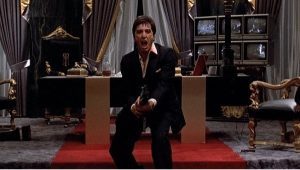The scene I am analysing is linear and realist as, although it is akin to a montage occurring over a smaller part of Henry’s life, it contains a linear sequence of cuts and narrative. It is realist, as all of the mise-en-scene is typical of 1950s Brooklyn, New York, Mafia culture. This part of the story is told using dialogue and extensive narration from an older Henry Hill.
The gangster genre is made evident through the codes and conventions of the film. These codes include the Cadillacs, sharp suits and slicked-back hair, typical of the Mafia, the dingy lighting in the interior of buildings, to hide illegal activity from prying eyes, the excessive use of guns, knives and money to solve problems, the suburbs of New York, known for their strong Mafia presence and corrupt police officers, and the use of red and white in the title language. Conventions include several different plots – mainly surrounding the distribution of guns, drugs and money – actors traditionally associated with gangster-type films, such as Robert De Niro and Joe Pesci, a luxurious but fragile lifestyle, worsened by overindulgence in narcotics, and a prominent soundtrack composed of mid-20th century songs (music contemporary to, or older than, the respective era in Henry’s life).
The film certainly caters to the audience’s expectations of the genre: Scorsese was enthusiastic about the prospect of creating an incredibly fast-paced film, stating that “the impact after about an hour and a half would be terrific.” Scorsese used the extensive freeze-frames, similar to Jules and Jim (1962), to highlight that “a point was being reached” in Henry’s life: similar to the appearance of the monolith in mankind’s evolution, in 2001.
Goodfellas shares many visual and stylistic elements with Scarface (1983, dir. Brian De Palma), such as the location of New York City, the degradation of the protagonist, after taking progressively more copious amounts of cocaine, the extensive use of guns, the frequent setting of the nightclub, sharp suits and the establishment of a cocaine operation, separate from the kingpin, to name a few. The frenzy of the end of the film, where dozens of Sosa’s flunkies infiltrate Tony Montana’s (Al Pacino) manor and Tony bursts through the door, yelling the infamous line, “Say hello to my little friend”, is mirrored by the deliration of Henry’s manic day near the end of Goodfellas.

Tony Montana, Scarface (1983), “Say hello to my little friend!”
![Film Analysis (2001: A Space Odyssey | Goodfellas) [Part 6]](https://joestudios.co.uk/wp-content/uploads/2021/04/DSCF0361-Optimised.jpg)